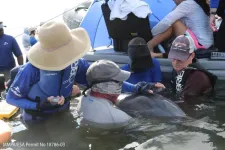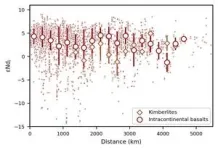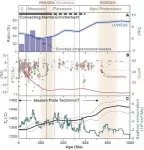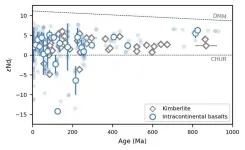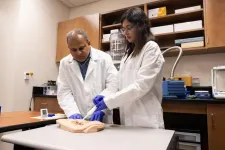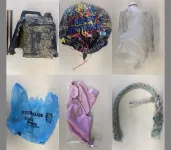(Press-News.org) U.S. researchers have detected microplastic particles in air exhaled by wild bottlenose dolphins, suggesting that inhalation may be a relevant route of exposure to these potentially harmful contaminants. Miranda Dziobak of the College of Charleston in South Carolina, U.S., and colleagues present these findings in the open-access journal PLOS ONE on October 16, 2024.
Around the world, humans and numerous other animals are exposed to tiny particles of plastic contaminants known as microplastics. In humans and rodents, microplastic exposure has been linked to adverse health impacts, such as oxidative stress and inflammation. Ingestion of foods contaminated with microplastics is a major route of exposure for both humans and wildlife, and inhalation of airborne microplastics has been linked to adverse health effects in humans.
However, few studies have examined inhalation as a potential route of microplastic exposure for wildlife. Now, this research team has collected samples of exhaled air from five bottlenose dolphins in Sarasota Bay, Florida, and six bottlenose dolphins in Barataria Bay, Louisiana during catch-and-release health assessment studies. To capture the air, they held a collection surface over or just above each dolphin’s blowhole as it exhaled.
Analysis of the collected air showed that all 11 dolphins had at least one suspected microplastic particle in their breath. Further analysis of the exhaled microplastic particles showed that they included both fibers and fragments and included several types of plastic polymers, including polyethylene terephthalate (PET), polyester, polyamide, polybutylene terephthalate, and poly(methyl methacrylate), also known as PMMA.
For comparison, the research team had also sampled the surrounding air near the dolphins, allowing them to confirm that the detected microplastics were not just airborne near the blowholes but were actually exhaled.
These results support the idea that inhalation could be another key route of microplastic exposure for dolphins, alongside ingestion. However, the authors note that their findings are preliminary, and that further research will be needed to better quantify the degree of inhalation exposure to various types of microplastics among bottlenose dolphins, as well as to determine the potential impacts on dolphins’ health, such as the possibility of lung damage.
The authors add: “We know that microplastics are floating around in the air, so we suspected that we would find microplastics in breath samples. We are concerned by what we are seeing because dolphins have a large lung capacity and take really deep breaths, so we are worried about what these plastics could be doing to their lungs.”
#####
Author Interview: https://plos.io/3Nh6GrK
In your coverage please use this URL to provide access to the freely available article in PLOS ONE: https://journals.plos.org/plosone/article?id=10.1371/journal.pone.0309377
Citation: Dziobak MK, Fahlman A, Wells RS, Takeshita R, Smith C, Gray A, et al. (2024) First evidence of microplastic inhalation among free-ranging small cetaceans. PLoS ONE 19(10): e0309377. https://doi.org/10.1371/journal.pone.0309377
Author Countries: USA, Sweden
Funding: Research reported in this publication was supported by the National Institute of Environmental Health Sciences of the National Institutes of Health under Award Number R15ES034169 [LH]. The content is solely the responsibility of the authors and does not necessarily represent the official views of the National Institutes of Health. Sarasota Bay health assessments were funded primarily by Dolphin Quest, Inc. AF was funded by Fundacion Oceanografic and Global Diving Research SL. Barataria Bay health assessments were funded primarily by a Strategic Environmental Research and Development Program grant (no. RC20-1097), with contributions from the Gulf of Mexico Research Initiative and the National Marine Mammal Foundation [CRS, RT].
END
Microplastics detected in dolphin breath
U.S. study suggests dolphins could be exposed to potentially harmful microplastics through inhalation
2024-10-16
ELSE PRESS RELEASES FROM THIS DATE:
Global north’s growing appetite for farmed salmon imperils communities’ access to local fish
2024-10-16
A new paper published today in Science Advances exposes the global aquaculture sector’s growing dependence on wild fish. Despite industry claims to the contrary, these findings highlight how the growing appetite for expensive farmed salmon can leave coastal communities struggling to access affordable local fish like sardines and anchovies. Instead, these small pelagic fish are frequently caught, processed, and “reduced” to fishmeal and fish oil, almost all of which is used to feed farmed fish. These ‘reduction fisheries’ account for 26% of global ocean catch.
“As the aquaculture industry grows, so does its ...
e-Flower records neuronal activity with electronic petals
2024-10-16
Neural spheroids — 3D clusters of brain cells — are emerging as essential tools for understanding neural networks and studying neurological diseases in the lab. EPFL’s e-Flower, a flower-shaped 3D microelectrode array (MEA), allows researchers to monitor the electrical activity of these spheroids in a way that was previously impossible. This breakthrough, published in Science Advances, lays the groundwork for more sophisticated research on brain organoids, which are complex, miniaturized models of brain tissues.
“The ...
Aquaculture uses far more wild fish than previously estimated, study finds
2024-10-16
A study published in the journal Science Advances suggests that global fish farming, or aquaculture, may rely on significantly larger quantities of wild-caught ocean fish than previously calculated. The study is part of a special issue focused on expanding contributions from the aquaculture industry to food systems with an aim towards sustainability.
These findings call into question long-held assumptions about the sustainability of the rapidly growing aquaculture industry and provides a range of plausible estimates for its impact on wild fish populations.
The research, led by an international team of scientists ...
Gene editing approach paves the way to first-in-human clinical trial for rare genetic disease
2024-10-16
A collaborative effort between investigators at the National Institutes of Health’s National Institute of Allergy and Infectious Diseases (NIAID) and Massachusetts General Hospital (MGH), a founding member of the Mass General Brigham healthcare system, demonstrates the potential of precise genome editing technologies, called adenine base editors, to correct disease-causing mutations in stem cells from patients with X-linked chronic granulomatous disease (X-CGD), a rare genetic disorder characterized by high susceptibility to infections. The findings are published in Science Translational Medicine.
Patients with ...
Compositional evolution of the upper mantle driven by plate tectonics
2024-10-16
On present-day Earth, plate subduction continuously modifies the chemical composition of the convecting mantle, and various mantle sources linked to these processes have been widely studied.
However, when did global chemical heterogeneity of the convecting mantle first emerge in Earth's geological history? And how might Earth’s geodynamic evolution have influenced the chemical composition of the convecting mantle over time?
Researchers from the Institute of Oceanology of the Chinese Academy of Sciences (IOCAS), along with collaborators from Australia, Switzerland and the USA, have tried to address these questions ...
Virtual reality game used to help students in science classes
2024-10-16
Multilingual students face unique challenges that can hurt their performance in school. New methods of teaching may help close this gap, according to a new study from the University of Georgia.
In the United States, English is the main language used in classrooms. Schools also tend to rely on spoken communication to teach and written exams to assess learning.
That can make it difficult for multilingual students to express themselves. This is especially true in science classes, with their specific terms and complex sentence structures.
So a UGA researcher developed an immersive virtual reality game to communicate scientific ...
Life-saving spongelike “bandage” developed by UCF researchers rapidly stops hemorrhaging and mitigates risk of infection
2024-10-16
Video available here.
Without proper medical invention, injuries sustained from traffic collisions, serious workplace accidents or weapons may result in fatal hemorrhaging.
University of Central Florida researchers aim to prevent such bleeding in potentially deadly situations with a new hemostatic spongelike bandage with antimicrobial efficacy that they recently developed and detailed in a newly published study in the journal Biomaterials Science.
“What happens in the field or during an accident is due to heavy bleeding, patients can die,” says Kausik Mukhopadhyay, assistant professor of materials ...
Model reveals why debunking election misinformation often doesn’t work
2024-10-16
When an election result is disputed, people who are skeptical about the outcome may be swayed by figures of authority who come down on one side or the other. Those figures can be independent monitors, political figures, or news organizations. However, these “debunking” efforts don’t always have the desired effect, and in some cases, they can lead people to cling more tightly to their original position.
Neuroscientists and political scientists at MIT and the University of California at Berkeley have now ...
Project to integrate human and machine intelligence to address information integrity
2024-10-16
Identifying whether online information is faulty or ungrounded is important to ensure information integrity and a well-informed public. This was especially challenging during the COVID-19 pandemic when misinformation spread like wildfire across the Internet. A new project led by Dong Wang, associate professor in the School of Information Sciences at the University of Illinois Urbana-Champaign, will integrate diverse human and machine intelligence to examine multimodal data (e.g., text and image) that was produced during the pandemic. ...
Plastic pollution sounds just like food to deep-diving whales
2024-10-16
BEAUFORT, N.C. -- To whales that hunt with soundwaves in the lightless depths of the ocean, a torn plastic party balloon and a delicious squid seem to be remarkably similar, according to a new study that put some plastic beach trash through underwater acoustic testing.
"These acoustic signatures are similar, and this might be a reason that these animals are driven to consume plastic instead of, or in addition to, their prey," said Duke University graduate student Greg Merrill, who led the research.
"One hundred percent of plastic marine debris ...
LAST 30 PRESS RELEASES:
When is it time to jump? The boiling frog problem of AI use in physics education
Twitter data reveals partisan divide in understanding why pollen season's getting worse
AI is quick but risky for updating old software
Revolutionizing biosecurity: new multi-omics framework to transform invasive species management
From ancient herb to modern medicine: new review unveils the multi-targeted healing potential of Borago officinalis
Building a global scientific community: Biological Diversity Journal announces dual recruitment of Editorial Board and Youth Editorial Board members
Microbes that break down antibiotics help protect ecosystems under drug pollution
Smart biochar that remembers pollutants offers a new way to clean water and recycle biomass
Rice genes matter more than domestication in shaping plant microbiomes
Ticking time bomb: Some farmers report as many as 70 tick encounters over a 6-month period
Turning garden and crop waste into plastics
Scientists discover ‘platypus galaxies’ in the early universe
Seeing thyroid cancer in a new light: when AI meets label-free imaging in the operating room
Neutrophil-to-lymphocyte ratio may aid risk stratification in depressive disorder
2026 Seismological Society of America Annual Meeting
AI-powered ECG analysis offers promising path for early detection of chronic obstructive pulmonary disease, says Mount Sinai researchers
GIMM uncovers flaws in lab-grown heart cells and paves the way for improved treatments
Cracking the evolutionary code of sleep
Medications could help the aging brain cope with surgery, memory impairment
Back pain linked to worse sleep years later in men over 65, according to study
CDC urges ‘shared decision-making’ on some childhood vaccines; many unclear about what that means
New research finds that an ‘equal treatment’ approach to economic opportunity advertising can backfire
Researchers create shape-shifting, self-navigating microparticles
Science army mobilizes to map US soil microbiome
Researchers develop new tools to turn grain crops into biosensors
Do supervised consumption sites bring increased crime? Study suggests that’s a myth
New mass spec innovation could transform research
Maternal nativity, race, and ethnicity and infant mortality in the US
Migration-related trauma among asylum seekers exposed to the migrant protection protocols
Jupiter’s moon Europa has a seafloor that may be quiet and lifeless
[Press-News.org] Microplastics detected in dolphin breathU.S. study suggests dolphins could be exposed to potentially harmful microplastics through inhalation
